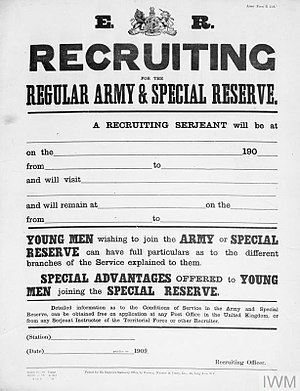| Special Reserve | |
|---|---|
 Recruitment poster for the British Army and Special Reserve | |
| Active | 1908–1919 |
| Country | |
| Type | Army reserve |
The Special Reserve was established on 1 April 1908 with the function of maintaining a reservoir of manpower for the British Army and training replacement drafts in times of war. Its formation was part of the military reforms implemented by Richard Haldane, the Secretary of State for War, which also created the Territorial Force. Haldane originally intended that the Militia would provide the reserve, but opposition from its representatives forced him to abolish it and create the Special Reserve instead. Only 60 per cent of the Militia transferred into the new reserve, and it was consistently under strength, particularly in officers. Reservists enlisted for a six-year term of service, and had to undergo six months of basic training on recruitment and three to four weeks training annually.[1]
The Special Reserve was organised into battalions, providing the third for each of the regular army's 64 two-battalion infantry regiments and a fifth and sixth for the five four-battalion infantry regiments. In addition to providing replacements to the regular army, the Special Reserve was deployed on home defence duties guarding the coast and key installations during the First World War. The routine nature of its duties meant that scant attention was paid to it in regimental histories. After the war, the Special Reserve was abolished and the Militia was resurrected in 1921 to take on its former role. No effort was made to restart recruitment, and in 1924 the new Militia's functions were absorbed into the Supplementary Reserve.
- ^ Baker, Chris. "British army reserves and reservists". Retrieved 10 March 2024 – via The long, long trail.
2. Special Reserve This was a form of part-time soldiering, in some ways similar to the Territorial Force